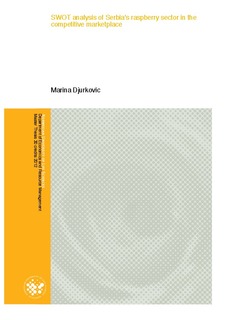| dc.description.abstract | This study investigates the raspberry sector in Serbia over the period 1992 to 2009 with the main purpose to reveal how the sector has been affected by relevant factors focusing on the comparative and competitive advantages and challenges confronting the world raspberry market.
Raspberry, as an export oriented product and one of the most important single commodity in Serbia's agriculture was selected for this analysis considering its crucial role for agricultural
production and trade. The main objective of the study is to identify internal and external factors that create competitive advantage of the Serbia's raspberry sector against its major competitors and explore ways to increase the competitiveness of the industry.
SWOT analysis has been used as a framework to identify the strengths, weaknesses, opportunities and threats of the raspberry sector in Serbia with respect to its main competitors, Poland and Chile. The research showed that the basic strengths of the sector are the existence of
favourable factor conditions and low labor costs and that the roots from the sector's weaknesses comes from the fragmented raspberry production, poorly organized marketing channel and insufficient government support. Increased exports to the new markets, Russia and Japan is the
opportunity of the sector to achieve higher level of the competitiveness. The main threat comes from the Serbia's main competitors Poland and Chile, especially in the frozen raspberry market.
In order to maintain leading position in raspberry production and export worldwide and increase the competitiveness on the global market, Serbia's raspberry sector need to ensure horizontal and
vertical integration within marketing channel, by intensifying cooperation between all participants of the value chain. Looking at the competitors' strengths and weaknesses will allow Serbia to work out where they can pose threats and will help Serbia’s sector determine how and
where its product should be placed in the market. | no_NO |
